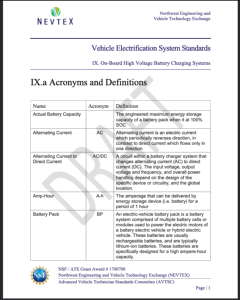Vehicle Electrification Systems Standards: On-Board High Voltage Battery Charging Systems
- IXa_Acronyms and Definitions.pdf
- IXb. Overview of On-Board High Voltage Battery Charging Systems.pdf
- IXc. On-Board High Voltage Battery Charging Systems Components.pdf
- IXd. On-Board High Voltage Battery Charging Systems Operation.pdf
- IXe. On-Board High Voltage Battery Charging System Diagnostics.pdf

Vehicle Electrification Systems Standards Curriculum Description:
The Vehicle Electrification Systems Standards curriculum is provided by the Northwest Engineering and Vehicle Exchange (NEVTEX) and developed by Central Oregon Community College (COCC) and Rio Hondo College (RHC). COCC and RHC worked together "to develop curriculum and training standards for technicians in hybrid electric vehicle (HEV), electric vehicle (EV), and Fuel Cell (FC) vehicle systems." This curriculum was developed with the intention of addressing industry needs by partnering with industrial and educational representatives to obtain input and assistance to develop:
- new approaches to prepare an advanced technologies workforce,
- licensure procedures and policies to ensure the safety of technicians, their employers, and clients, and
- collaboration between educational and industrial partners in the development of new standards and practices.
The Vehicle Electrification Systems Standards are divided into 11 topics. This section of the standards covers the topic Vehicle Electrification On-Board High Voltage Battery Charging Systems. The other 10 topics and a Master Acronym and Definition list are available to view separately.
On-Board High Voltage Battery Charging Systems Description and Contents:
This section of the Standards includes the following five lesson plans: IX. a - Acronyms and Definitions; IX. b - Overview of On-Board High Voltage Battery Charging Systems; and IX.c - On-Board High Voltage Charging Systems Components; IX. d - On-Board High Voltage Battery Charging Systems Operations; IX. e - On-Board High Voltage Battery Charging Systems Diagnostics and Service. Each lesson plan covers different aspects of on-board high voltage charging systems. The lesson plans include a description, objectives, tools, tasks, and outcomes.
The 11-page acronyms and definitions lesson plan provides an overview of the terms related to on-board high voltage battery charging systems.
The 3-page on-board high voltage battery charging systems overview lesson plan asks students
to "locate the OBC module, convert kW-h to A-h units, identify what levels of charging are utilized on any given vehicle type and model, determine the approximate charging time of a battery pack, and analyze the performance of the OBC system using off-board analysis tools.”
The 2-page lesson plan on on-board high voltage battery charging systems components, students will be able to “identify all OBCM internal components, trace OBC wire/cable system routing of all electrical harnesses, and identify charging connection electrical terminals, and identify the OBCM.”
The 4-page system operations lesson plan has students, “identify components in circuit diagrams and how each stage of the OBC operates...” to learn “how charging times and necessary kW, how CC/CV charging strategies are utilized, charging connector configurations, and diagnosing high voltage battery pack and charging systems failure modes are essential educational elements.”
The 2-page diagnostics and service lesson plan has students use “test vehicles, graphics and diagrams to test and check the functionality of the OBC, OBC charging controls, and service of the OBC system using specialized tools, electronic testers, and Scan Tool.”
About this Resource


Comments